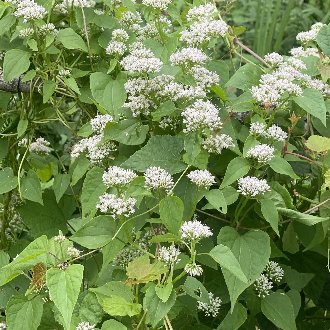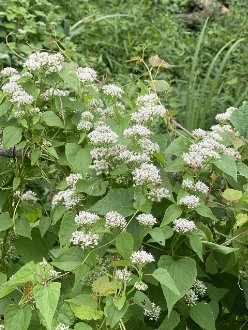Climbing Hempvine (Mikania scandens (L.) Willd.)
Also known as climbing hemp vine, climbing hempweed, louse-plaster.
BONAP also recognizes Mikania batatifolia DC as a separate species that occurs only in southern Florida, but, per the treatment of POWO, we consider that merged in with this species.
↑Range - Expand
| Legend | Color |
| Native | |
| Native or Not Present |
This tentative map is based on our own research. It may have limited data on Canada and/or Mexico, and there is some subjectivity in our assignment of plants as introduced vs. expanded. Read more in this blog post.
Although this plant occurs somewhere in each of these regions, it may only occur in a small part of some or all of them.
This species is also native to Mexico, but we have yet to build this portion of its range map. GRIN says it is native only to Tamaulipas, but GBIF shows extensive records farther south in eastern Mexico and we have yet to examine the validity of these records.
↑Habitat
Climbing hempvine is found on disturbed sites in partly-shaded wetlands primarily in the southeastern US into Mexico, but extending also into coastal New England and somewhat into the interior of the US. Its natural habitats include openings in floodplain forests, swamps, wet meadows, beaver ponds, banks of streams and ponds, both freshwater and saltwater marshes, and ponds and swales between coastal dunes. It is also found in anthropogenic habitats including roadside ditches and levees.
It tolerates a wide range of soil pH. We saw some sources giving pH ranges of 5.7 to 7.5 but it may tolerate both higher and lower pH. It tolerates some degree of salinity in the waters it grows near.
Because of its vining habit and tendency to occur on borders, plants are usually rooted in moist conditions but not standing water, but can climb up onto drier ground, as well as climbing supporting vegetation to hang over open water.
↑Life Cycle
Climbing hempvine is a perennial herbaceous vine that climbs by twining or sprawling. It lacks tendrils or aerial rootlets, but it can root at nodes when it comes into contact with soil. Vegetative reproduction is important in some habitats, whereas reproduction by seed helps it to colonize new, more distant sites. Vegetative reproduction helps this plant to adapt to changing water levels such as are common along shorelines.
In most of its range, it flowers in late summer into fall, with seeds maturing shortly thereafter but in the south of its range, particularly in Florida, it has a broader bloom time and can bloom continually over a long period as long as favorable conditions persist, with seeds maturing incrementally as the plant continues to bloom. Seeds are dispersed by a combination of wind, water, and animals; wind carries the seeds some distance, but they are also prone to stick to animal fur, and can also be carried by water when they land in water.
We could not find comprehensive information on this species' behavior in the seed bank, but it has been reported emerging from the soil seed bank so it likely can persist for some amount of time. However the relative importance of seed banking vs. freshly-distributed seeds is not known.
We also could not find information on the typical lifespan of this plant in the wild. Mortality likely occurs from a variety of different causes; on swampy sites that experience a prolonged period without disturbance, plants can be shaded out by a closed canopy of trees. Plants can also be drowned by rising water levels if the vine is not able to re-root on a higher, drier spot, or killed by drought or competetion from more drought-tolerant vegetation during prolonged dry spells or when water levels fall. Its ability to survive changing water levels is dependent on the availability of suitable micro-sites to root in at a new suitable level.
↑Faunal Associations
The leaves are eaten by a variety of mammals, including both wild ones and livestock, contrasting with the foliage of most other members of the Eupatorieae tribe, which have varying levels of toxicity but are generally less palatable to mammals.
↑Control
Other members of the Mikania genus have become invasive outside their native range. This species has been introduced into Central Africa, where it persists in the wild in at least 5 different countries; it likely has some invasive potential and for this reason we recommend avoiding planting it anywhere that is not in or directly adjacent to its native range.
↑Uses
This species is occasionally used as a cover crop, and then also used as fodder for livestock.
It is occasionally used as a landscaping plant, where it is valued for its showy flower clusters. It can also be used in ecological restoration projects in wetlands, where it has the benefit of quickly covering large areas of exposed soil on disturbed sites.
↑Related Plants
Mikania scandens is the most northerly-reaching species of its genus anywhere in the world; in most of its range it is the only member of its genus, but in the south of its range it also overlaps with the Florida keys hempvine (Mikania cordifolia). Most of the members of this genus are tropical.
More broadly, this species belongs to the Eupatorieae tribe of the aster family, which has a large number of species in North America, most of which are native.
↑Links & External Resources
• Mikania scandens (climbing hempvine) | USDA PLANTS Database (About This Site)
• Mikania scandens | Go Botany (About This Site)
• Mikania scandens | Biota of North America Project (BONAP) (About This Site)
• Mikania scandens | NatureServe Explorer (About This Site)
• Mikania scandens | Flora of North America (About This Site)
• Mikania scandens | Missouri Plants (About This Site)
• Climbing Hempvine | Maryland Biodiversity Project (About This Site)
• Mikania scandens (L.) Willd. | Plants of the World Online (POWO) (About This Site)
• Mikania scandens (L.) Willd. (Climbing Hempweed) | Digital Atlas of the Virginia Flora (About This Site)




